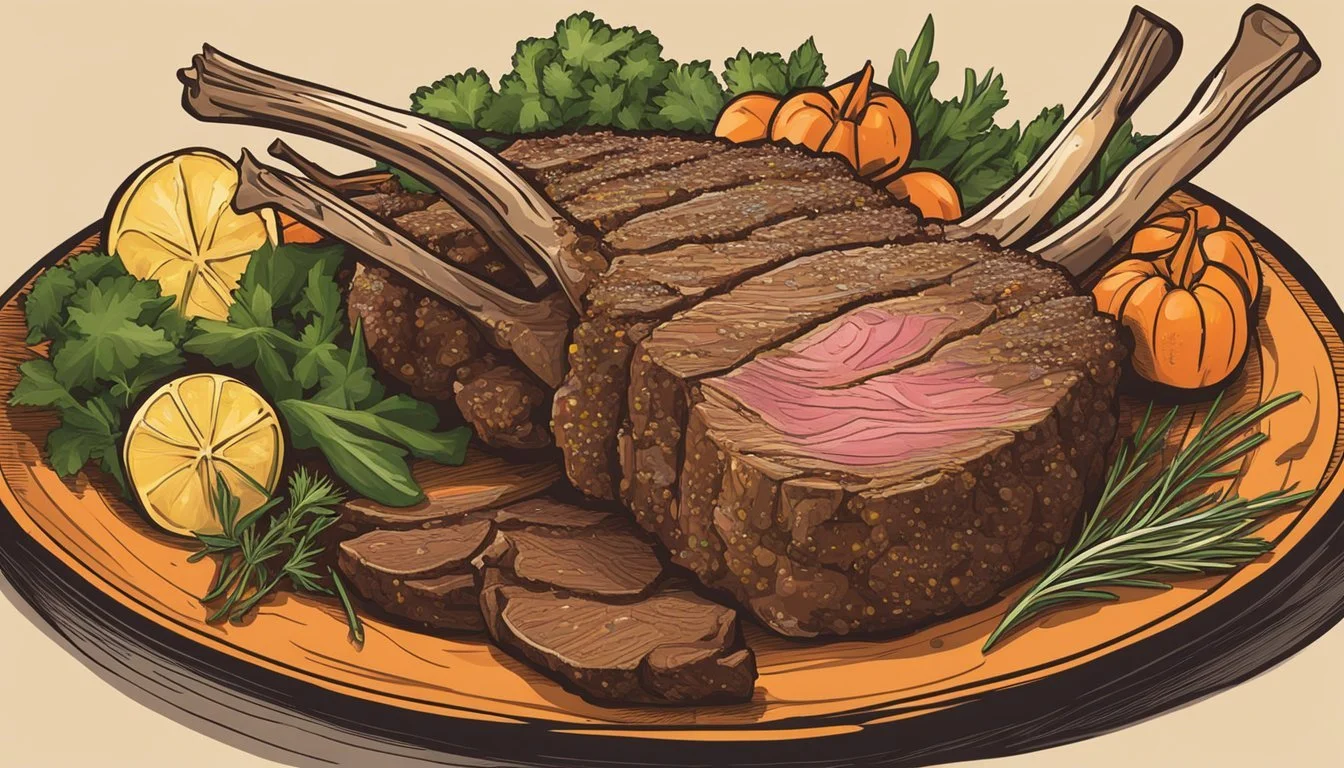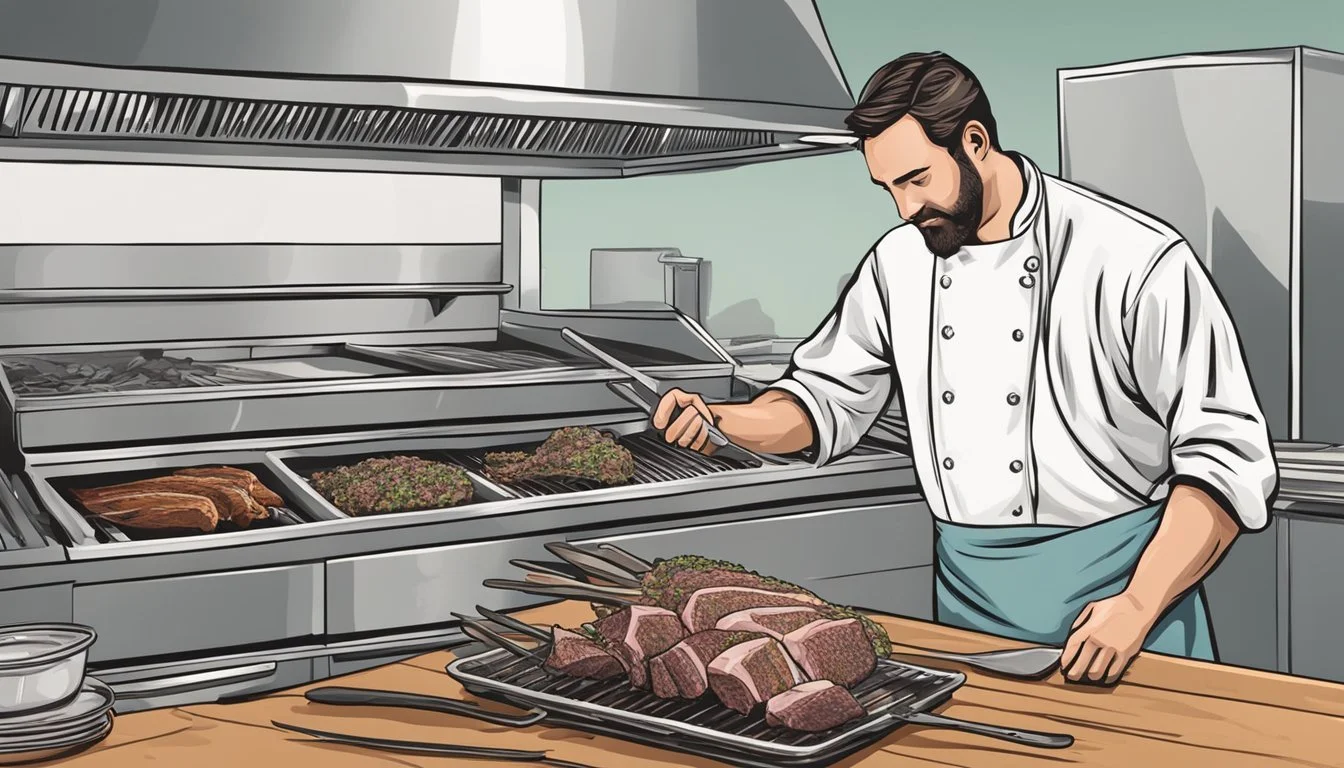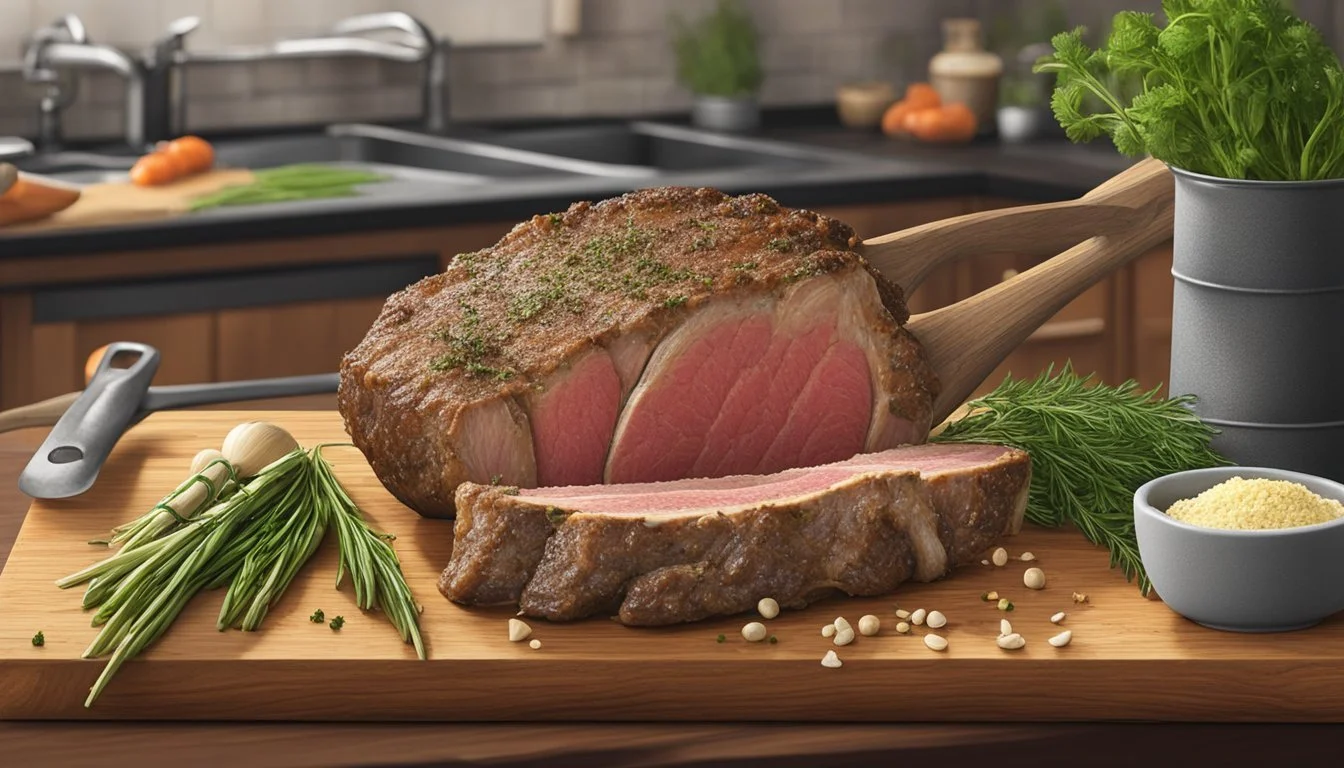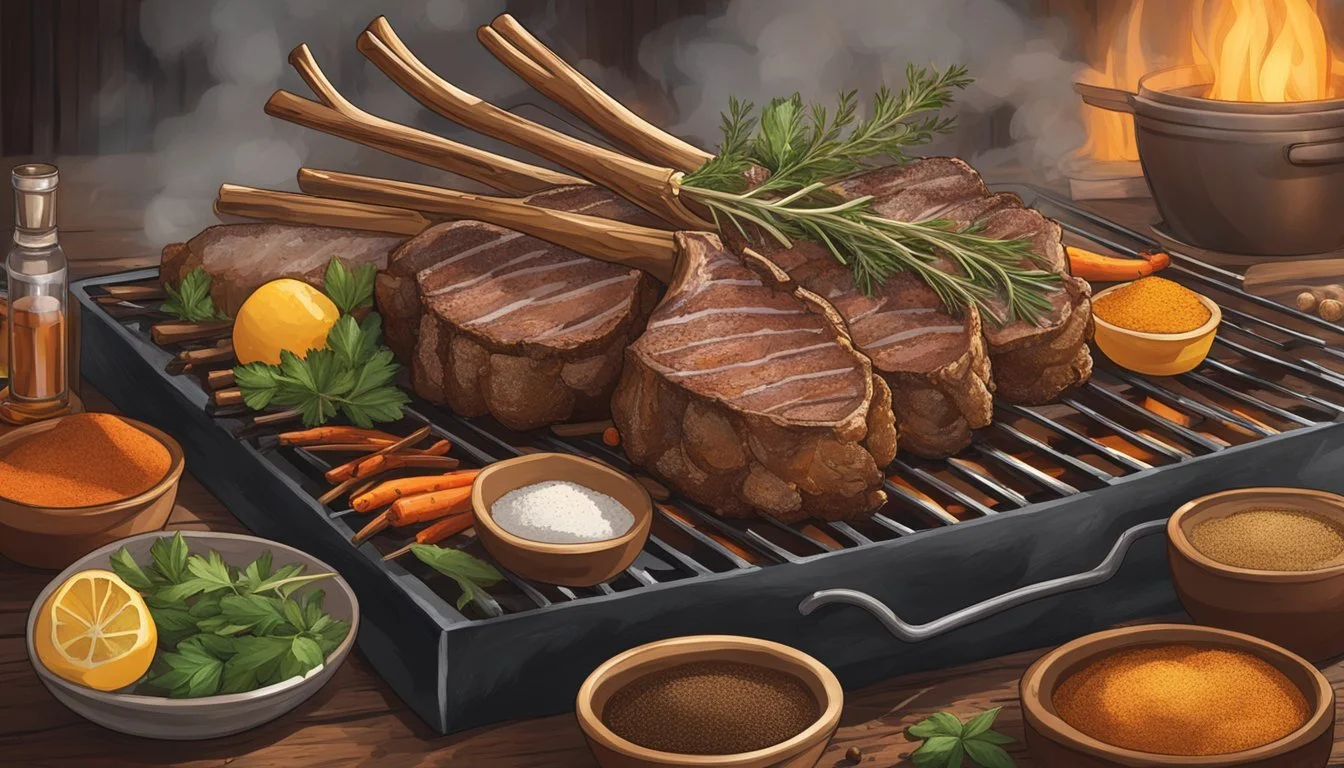How to Prepare a Texas-Style Rack of Lamb
Your Ultimate Guide
A Texas-Style Rack of Lamb is a culinary delight that infuses the succulence of lamb with bold flavors commonly found in Texan cuisine. This recipe takes the tender cut of a rack of lamb and elevates it through a combination of spices, searing techniques, and a complementary sauce that captures the essence of the Southwestern palate. The preparation is straightforward and when executed properly, results in a dish that's both visually appealing and deeply satisfying to the taste buds.
Seasoning is at the heart of any Texas-style dish, and a rack of lamb is no exception. The process involves marinating or rubbing the meat with a blend of spices that might include garlic, rosemary, and other herbs, tailored to enhance the natural richness of the lamb without overpowering it. Cooking methods often reflect the Texan spirit of grilling and roasting, ensuring the exterior gains a crispy texture while the interior remains tender and juicy.
Balance is key in this recipe, as the robust seasoning must complement the lamb rather than dominate it. A rack of lamb prepared in Texas style is often accompanied by a sauce—perhaps a red wine reduction or a tangy barbecue glaze—that provides a counterpoint in flavor and adds moisture to the meat. Pairing the dish with a side that can stand up to the pronounced tastes, like roasted vegetables (What wine goes well with roasted vegetables?) or a hearty salad, completes the experience and showcases the versatility of this southern-inspired fare.
Choosing Quality Lamb
In the pursuit of preparing a Texas-style rack of lamb, selecting the right cut and ensuring its freshness are paramount for achieving a succulent and flavorful result. Here's how one can identify quality lamb that's ideal for a robust grill-focused dish like the one Texas is famed for.
Understanding Lamb Cuts
Texas-style cooking often employs a larger, more robust flavor profile, so choosing the right cut of lamb is crucial. Rack of lamb is a prime cut known for its tenderness and flavor. It includes rib bones, loin meat, and a generous fat cap that imparts rich taste when rendered on the grill. Other popular cuts for different preparations include:
Lamb Chops (What wine goes well with lamb chops?): Typically from the rib or loin, these are perfect for quick, high-heat cooking.
Lamb Ribs: A more adventurous option that takes well to slow cooking.
Lamb Shoulder: A tougher cut that, when slowly roasted, becomes incredibly tender.
Each cut has its own unique texture and ideal cooking method that affects the final dish's flavor profile.
Selecting Fresh Lamb
When selecting a rack of lamb, there are several indicators of freshness and quality one should look for:
Color: The meat should be a vibrant red or pink; darker purplish hues signal older lamb.
Texture: The meat should be firm to the touch with a consistent grain.
Fat Cap: Look for a rack with a healthy layer of white fat, which should not be overly thick or thin. It keeps the meat moist during cooking and adds flavor.
Smell: Fresh lamb has a clean, slightly sweet scent. Any sour or strong odors suggest it may be past its prime.
Packaging: If buying prepackaged lamb, ensure it's well sealed and that the packaging doesn't contain excess liquid.
Always source lamb from reputable butchers and markets to ensure the highest quality. Freshness impacts the lamb's taste after it's been grilled, giving it the flavorful, tender texture desired in Texas-style preparations.
Preparation Essentials
In preparing a Texas-style rack of lamb, a cook's attention to the nuances of trimming, marinating, and seasoning is crucial. These steps ensure that the lamb's texture and flavor are optimized for a succulent, aromatic finish.
Trimming The Rack
Before seasoning, one should properly trim the rack of lamb. Removing any excess fat ensures even cooking and helps the marinade permeate the meat more effectively. The fat cap should be neatly trimmed, leaving a small layer for flavoring during the roasting process.
Creating The Marinade
A robust marinade is key to imparting flavor and tenderness to the lamb. A recommended Texas-style garlic herb marinade includes:
Olive Oil: The oily base carries flavors and helps the coating adhere to the meat.
Fresh Garlic: Crushed or minced, garlic adds a pungent depth.
Rosemary: Chopped finely, it infuses the meat with its signature piney aroma.
Fresh Thyme and Oregano: These herbs contribute earthy notes.
Dijon Mustard: It acts as an emulsifier and adds a tangy complexity.
Honey: A hint of sweetness balances the savory elements.
Black Pepper: Coarsely ground, it adds a spicy kick.
Combine these ingredients thoroughly for a consistent marinade.
Marinating For Flavor
The marinating process allows the lamb to absorb a medley of flavors. Place the trimmed racks in a suitable container or sealable bag with the marinade, ensuring the meat is well-coated. Refrigerate for a minimum of 12 hours, but no more than 48 hours, to allow the flavors to infuse. Prior to roasting, let the lamb sit at room temperature for about an hour to ensure even cooking.
Seasoning Techniques
When preparing a Texas-style rack of lamb, it's essential to master the art of seasoning to enhance the meat's natural flavors. A well-seasoned crust is key for creating that perfect blend of savory and umami tastes that Texas-style cooking is known for.
Applying The Rub
A crucial step in seasoning is to generously apply the rub to the rack of lamb. One begins by patting the meat dry to ensure proper adherence of the spices. For a typical Texas-style rub, kosher salt and black pepper form the base. Adding garlic powder intensifies the rub's flavor profile, giving depth to the crust. The rack should be evenly coated on all sides, ensuring that every bite is flavorful.
Essential Rub Ingredients:
Kosher salt
Black pepper
Garlic powder
Layering Flavors
To attain the iconic flavor complexity, layering different seasonings is recommended. One must incorporate fresh rosemary to infuse the lamb with a piney aroma typical of Texas cuisine. For added savory and umami flavors, Hardcore Carnivore Camo Seasoning could be considered, a blend that complements the lamb's richness without overpowering it. This elevation makes use of fresh herbs (how long do fresh herbs last?), showcasing the freshness against the robust base of the rub. When all elements are combined, they create a multidimensional crust that is both savory and rich in flavor.
Flavor Layering Components:
Fresh rosemary
Hardcore Carnivore Camo Seasoning
Additional fresh herbs (as desired)
Cooking Methods
When preparing a Texas-style rack of lamb, the cooking methods chosen can enhance the meat's flavor and tenderness. Grilling imparts a smoky character, oven roasting ensures even cooking, and properly resting the meat allows for optimal juiciness. Temperature control is crucial in each method to achieve the desired level of doneness.
Grilling
To grill a rack of lamb, preheat the grill to a high temperature, aiming for about 450°F to 500°F, allowing the grill grates to get hot enough to sear the meat. The lamb should be seasoned to preference before going on the grill. For a Texas-style flavor, one might consider using a spice rub that includes elements like cumin, chili, and garlic. Grill the lamb over direct heat to develop a charred exterior, turning it occasionally to promote an even color and to prevent burning. After searing, move the rack to indirect heat and cover the grill. This allows the interior to cook through more gently, preventing the exterior from burning while striving for an internal temperature of 135°F for medium-rare.
Oven Roasting
For oven roasting, the lamb requires seasoning and should be brought to room temperature before cooking to ensure even cooking throughout. Preheat the oven to 425°F to 450°F. While the oven heats, the cook might choose to sear the lamb in a hot skillet on the stove to develop a browned crust, then transfer it to a roasting pan. Place the lamb in the preheated oven and roast until the internal temperature reads 135°F for medium-rare, which is approximately 20 to 25 minutes. The removal of the silver skin before cooking is essential to avoid toughness in the finished dish.
Resting the Meat
After cooking, rest the lamb is a critical step. Allow the meat to rest uncovered for about 10-15 minutes before slicing. This waiting period permits the juices to redistribute throughout the meat, resulting in a more tender and flavorful experience. The temperature might continue to rise a few degrees during this time, so the chef should remove the lamb from the heat source a bit before it reaches the target internal temperature. Total time for preparation includes the prep time, cook time, and resting time, and all contribute to the perfect Texas-style rack of lamb.
Cooking to Perfection
Cooking a Texas-style rack of lamb to perfection involves achieving the ideal doneness and using reliable tools like a meat thermometer to ensure a tender, succulent result every time.
Achieving the Right Doneness
The key to a perfectly cooked rack of lamb lies in understanding the various levels of doneness. These are typically:
Rare: A cool red center with an internal temperature of approximately 120-125°F (49-52°C)
Medium Rare (Med Rare): A warm red center, preferred by many for its tenderness, with an internal temperature of 130-135°F (54-57°C)
Medium (Med): A warm pink center with an internal temperature of 140-145°F (60-63°C)
Medium Well (Med Well): A slightly pink center with an internal temperature of 150-155°F (65-68°C)
Well Done: A brown, no pink center with an internal temperature of 160°F (71°C) and above
Choosing the right level of doneness is a matter of personal preference, but Texas-style often favors a Medium Rare to Medium finish to ensure the lamb stays juicy and tender.
Using a Meat Thermometer
To precisely gauge doneness, chefs recommend using a meat thermometer. Here are two types to consider:
Instant Read Thermometer: Provides a quick, accurate reading and is ideal for spot checks.
Leave-In Meat Thermometer: Stays in the meat while cooking, allowing continuous monitoring.
The proper technique for using a meat thermometer is to insert it into the thickest part of the meat, avoiding fat or bone, which can give inaccurate readings. For a rack of lamb, here's a guide:
Doneness Internal Temp Range Rare 120-125°F (49-52°C) Medium Rare 130-135°F (54-57°C) Medium 140-145°F (60-63°C) Medium Well 150-155°F (65-68°C) Well Done 160°F (71°C) and above
Before serving, the lamb should rest for a few minutes as the internal temperature can rise slightly, known as carryover cooking. This step ensures juices redistribute for maximum tenderness.
Final Touches & Presentation
When the Texas-style rack of lamb is perfectly roasted, the final touches can elevate it from delicious to visually impressive. An impeccable crust forms the trademark of a well-prepared rack, combining both flavor and texture that is irresistible.
Firstly, letting the lamb rest after cooking is crucial. It should be allowed to sit for about 10-15 minutes before slicing. This step ensures that the flavors have time to settle and the juices redistribute, offering a more tender bite.
For an aromatic boost, chefs often garnish the lamb with fresh rosemary. Sprigs of rosemary can be arranged around the lamb on the platter, infusing an herby fragrance and providing a pop of green.
Serving is an art form. Each serving—typically consisting of one or two ribs per person—should be sliced cleanly between the bones. The visual appeal of perfectly cut lamb chops can make the dish even more impressive.
Incorporate a squeeze of lemon for a bright citrus note that cuts through the richness. A small bowl of lemon wedges can also be offered on the side.
Lastly, a Texas-style element can be brought in with a bold basil garnish, which pairs exceptionally well with the grilled rack of lamb with garlic herb marinade. Serve the lamb on a platter lined with fresh basil leaves, creating a sumptuous bed that hints at the bold flavors to come.
These final touches—and the thoughtful presentation of each element—signal a masterful command over the grill and a respectful nod to Texan flair.
Pairing and Accompaniments
Proper pairings and accompaniments can elevate the Texas-style rack of lamb, enhancing both the flavor and dining experience. Select wines that complement the bold spices of the lamb, and choose side dishes that bring balance and nutrition to the meal.
Wine Selection
For the Texas-style rack of lamb, wines that can stand up to the robust flavors are ideal. Specifically, bold red wines with a balance between tannins and fruitiness should be sought after. A few recommended choices include:
Cabernet Sauvignon: Its full-bodied profile with hints of dark fruit aligns with the lamb's hearty nature.
Syrah/Shiraz: Known for spicy notes, it pairs well with the smoky Texas rub on the lamb.
Merlot: Offering a softer tannin structure, it can provide a smooth contrast to the meal.
Wine should be served at the right temperature to ensure the flavor is not compromised. For red wines, that typically means around 60-65°F (15-18°C).
Side Dishes
The side dishes should offer a contrasting texture and lightness to counter the richness of the lamb. They should also bring nutritional balance without overwhelming the main course. Consider the following options:
Roasted Vegetables: A mix of carrots, potatoes, and parsnips roasted with herbs.
Nutrition Information: Low in calories, high in fiber.
Garlic Broccolini: Sautéed with garlic and finished with a squeeze of lemon.
Nutrition: A nutritious green providing vitamins with minimal calories.
Marinated White Beans: A refreshing bean salad with aromatic herbs.
Flavor: Complements the lamb without competing for attention.
Apple Slaw: A crunchy, fresh salad with a tangy dressing to cleanse the palate.
Nutrition Information: Adds a fruity freshness and fiber to the meal.
Each side dish should be well-seasoned and can be adjusted to personal preference or dietary needs.
Safety and Storage
When preparing a Texas-style rack of lamb, safety and proper storage are paramount to prevent foodborne illness and maintain the quality of the meat.
Temperature Control: Key to safety is ensuring the lamb is stored at a safe temperature before cooking. The USDA recommends storing lamb at or below 40°F in the refrigerator. While prepping, if the lamb must be left out, limit this time to two hours at room temperature to minimize bacterial growth.
Before Preparation: The rack of lamb should always be kept in its original packaging until it is ready to be prepared. If the meat must be stored for longer than the recommended sell-by date, it can be kept in the freezer where it will last for 6 to 9 months. Thawing should occur in the refrigerator, not at room temperature.
After Cooking: Once cooked, any leftovers should be stored promptly. The prime rib, backstrap, or any portion of the lamb needs to be refrigerated within two hours of cooking. It's best to slice the meat off the bone to facilitate quicker cooling.
Meat Type Refrigerated Storage Freezer Storage Rack of Lamb 3 to 4 days 6 to 9 months Prime Rib 3 to 5 days 6 to 12 months Backstrap 3 to 4 days 6 to 9 months
Reheating: Should the lamb be enjoyed later, it must be heated to an internal temperature of 165°F to ensure safety, even if the preferred doneness is less initially.
Properly storing and handling lamb not only ensures the safety of those consuming it but also preserves the meat's integrity. These guidelines help maintain the distinct flavors and tenderness that are the hallmarks of a perfectly prepared Texas-style rack of lamb.
Conclusion: Serving Texas-Style Lamb
When serving Texas-style lamb, presentation matters as much as the preparation. Ensure the lamb is tender to the touch, a sign that it has been cooked to perfection. The smoky aroma and the flavorful crust are trademarks of this regional delicacy, appealing to any lamb lover.
Upon removing the lamb from the cooking surface, it should rest for 10-15 minutes. This allows the juices to redistribute, maintaining the meat's tenderness and moisture.
To create an authentic Texas BBQ experience, complement the lamb with "BBQ Must Haves"—traditional sides such as coleslaw, baked beans, and cornbread. The robust, smoky flavors of the lamb pair well with these classic dishes.
For a themed event or a Sunday family dinner, consider adding "Hey Grill Hey" touches to your presentation. Utilize rustic platters and garnish with sprigs of rosemary to accentuate the lamb's herby crust.
Remember to carve the rack into individual chops for an elegant presentation. Offer a bold red wine or a smoked porter beer alongside the meal to enhance the lamb's natural flavors.
Smoked Leg of Lamb can be an alternative centerpiece for those looking to branch out. The slow-smoked process infuses the leg with a complex, rich taste that is both traditional and innovative.
By adhering to these suggestions, the Texas-style lamb will undeniably be the star of any dining occasion.










